Mad Hedge Biotech and Healthcare Letter
December 17, 2024
Fiat Lux
Featured Trade:
(THE BIG BATCH THEORY)
(CTLT), (DHR), (RGEN), (AVTR), (NVO), (PFE), (LLY), (MRK)

Mad Hedge Biotech and Healthcare Letter
December 17, 2024
Fiat Lux
Featured Trade:
(THE BIG BATCH THEORY)
(CTLT), (DHR), (RGEN), (AVTR), (NVO), (PFE), (LLY), (MRK)

If I had a nickel for every time someone said pharmaceutical manufacturing was boring, I could’ve started bidding against Novo Holdings for Catalent (CTLT) myself.
Sure, I’d still be $16.5 billion short, but you get the point—this deal is huge, and it’s about to make some smart money look even smarter.
Here’s the deal: Novo Holdings is shelling out $16.5 billion to snap up Catalent, a contract development and manufacturing organization (CDMO).
If that acronym sounds like alphabet soup, let me translate: CDMOs are where the real action happens.
These are the guys behind the curtain making sure your miracle drugs and life-saving treatments aren’t just ideas—they’re products hitting the market at scale.
The numbers don’t lie. The CDMO market sits at $146 billion right now.
Fast-forward to next year, and that balloons to $243.3 billion. By 2029, it’s cruising toward a cool $332 billion.
And if you think that’s impressive, just wait: the broader pharmaceutical outsourcing trend is nowhere near slowing down.
In 2014, Big Pharma still clung to in-house production for 66.3% of its output.
Today? That figure’s down to 51%, and dropping fast. Why? Because outsourcing lets the specialists handle the hard stuff—faster, cheaper, and more efficiently.
For investors, Catalent’s immediate upside is a no-brainer. The acquisition premium is pure gravy, but that’s not the whole story.
Rivals like Lonza Group (SWX: LONN) and Samsung Biologics are already feeling the heat.
The biologics CDMO market alone is expected to expand by $10.63 billion between 2024 and 2028, and you better believe those two are scrambling to stay ahead.
If you own shares, keep your seatbelt fastened. If you don’t, well… you might want to rethink that.
And here’s where it gets really interesting: Novo Holdings may be private, but its publicly traded golden child, Novo Nordisk (NVO), is set to ride this wave like a pro surfer.
They’re already a global powerhouse in biologics, and Catalent’s souped-up manufacturing capabilities are going to help them scale production with military-grade efficiency.
Lower costs, tighter operations, bigger margins—it’s like handing a Formula 1 car to an already championship-winning team.
So if you’re not watching Novo Nordisk stock, you’re doing it wrong.
Of course, it’s not just the big CDMO players who stand to win here. Companies like Danaher (DHR), Repligen (RGEN), and Avantor (AVTR) are quietly cashing in on this gold rush.
These firms supply the picks, shovels, and critical bioprocessing tools that CDMOs need to keep production humming.
As Catalent scales under Novo Holdings, demand for these essentials will go through the roof.
Zooming out, the pharma manufacturing landscape is evolving at a breakneck pace.
The CDMO market is expected to hit $530.3 billion by 2033, growing at a steady 7.7% CAGR.
That’s not speculative growth—it’s a structural shift, backed by demand for biologics, gene therapies, and personalized medicine.
In short, we’re entering an era where outsourcing is king, and companies with the infrastructure to capitalize on it are poised to dominate.
Don’t forget about the big dogs in Big Pharma, either.
Pfizer (PFE), Eli Lilly (LLY), and Merck (MRK) aren’t just spectators in this game. They’re snapping up CDMO capacity, investing in biologics, and doubling down on therapies with blockbuster potential.
The Catalent deal is just the latest chess move in a game where the stakes keep getting higher.
So what does this mean for you? If you’re holding Catalent, congratulations—your portfolio is about to get a nice bump.
But the real play here isn’t Catalent alone. It’s understanding that CDMOs, suppliers, and adjacent players are the unsung heroes of this industry transformation.
You want exposure to the companies enabling the next wave of medical innovation? This is where you look.
Novo Holdings just threw down the gauntlet, and the smart money is already moving. The pharmaceutical manufacturing sector isn’t boring—it’s booming.
So, while everyone’s chasing flashy biotech startups and blockbuster drugs, the real smart money is quietly following the companies that make those breakthroughs possible.
Catalent isn’t just a $16.5 billion deal—it’s proof that outsourcing is the new backbone of pharma’s future. Call it “The Big Batch Theory:” scale up, outsource smart, and watch the returns multiply.
Ignore this shift, and you’re leaving money on the table.
Now, if you’ll excuse me, I need to check my CDMO positions. Just like a perfectly run batch, they’re growing fast—and that’s exactly how I like it."
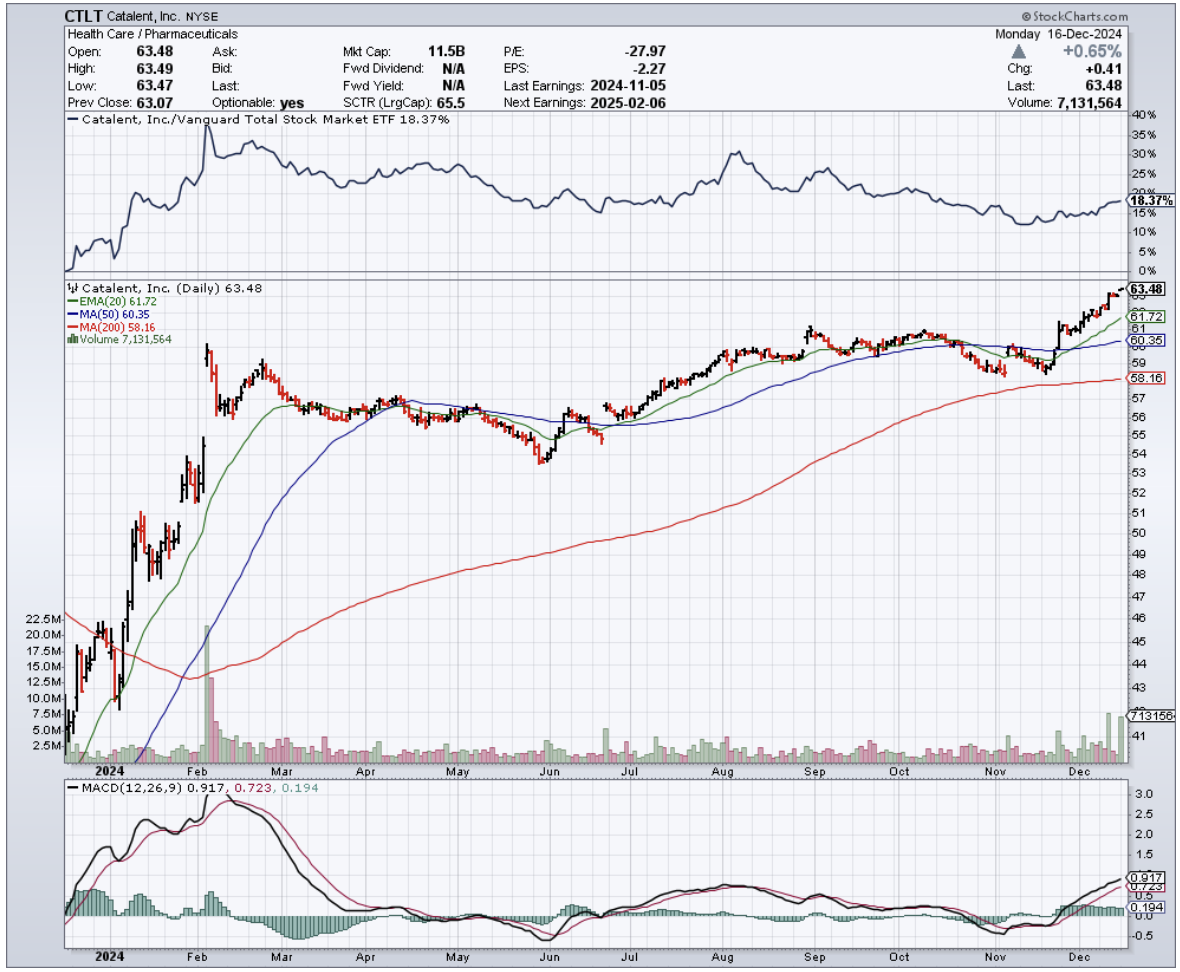
Mad Hedge Biotech and Healthcare Letter
December 12, 2024
Fiat Lux
Featured Trade:
(BREAKING THE MOLD)
(MRK), (PFE), (GILD), (AZN), (DSNKY), (JNJ)

Did you know that in the 1890s, scientists tried to cure cancer by injecting patients with... bread mold? (Spoiler alert: it didn't work.)
Fast forward to 2024, and Merck just announced something that makes moldy bread look like, well, moldy bread: their new cancer drug achieved a 100% complete response rate in its Phase 3 trial.
That's doctor-speak for "the cancer completely disappeared in every single patient." Not 99%. Not 99.9%. One hundred percent.
The drug in question is zilovertamab vedotin, and it belongs to a fascinating family of medications called antibody-drug conjugates, or ADCs.
These drugs are essentially molecular delivery trucks - the antibody part knows exactly where to go, while the drug part carries the cancer-fighting payload.
It's a bit like having a microscopic postal service that only delivers to cancer cells, except instead of Amazon packages, it's delivering something more lethal.
The story of how Merck got their hands on this drug is equally interesting.
In 2020, they wrote a check for $2.75 billion to acquire a company called VelosBio. To put that number in perspective, that's enough money to fund a small space program, or if you're feeling particularly eccentric, to buy 5.5 million laboratory mice (a purchase that would probably raise some eyebrows at the bank).
The global market for ADCs hit $7.72 billion in 2023, and some analysts predict it could reach $44 billion by 2029. I asked three different economists to explain these projections and got four different answers, but they all agreed on one thing: it's a lot of zeros.
And, as expected, the competition in this field is intense. Pfizer (PFE) bought Seagen for $43 billion. AstraZeneca (AZN) and Daiichi Sankyo (DSNKY) partnered up for Enhertu, while Gilead Sciences (GILD) nabbed Immunomedics and their wonderfully named drug Trodelvy.
Even Johnson & Johnson (JNJ), which most people associate with baby shampoo and that bottle of Band-Aids in their medicine cabinet, jumped into the fray by buying Ambrx Biopharma.
Then there's Mersana Therapeutics, partnered with Merck. They're smaller than the pharmaceutical giants, but in biotech, size isn't everything. (I once visited a lab where groundbreaking cancer research was happening in a space roughly the size of my kitchen.)
What makes Merck's achievement particularly remarkable is its rarity. In the world of cancer research, getting a 100% response rate is about as common as finding a unanimous decision on social media. It represents a fundamental shift in how we treat cancer, moving from traditional chemotherapy to these precisely targeted treatments.
For investors wanting a piece of this molecular magic, here's the thing: success in biotech isn't like picking a winning racehorse (though both can make your palms equally sweaty).
It's about finding companies that have mastered the three-ring circus of innovation, partnerships, and research pipelines. And yes, I've spent enough time in research facilities to know that "pipeline" is just a fancy word for "stuff we hope works but haven't broken yet."
Merck's perfect score suggests they've cracked one particular code, but companies like Seagen (now part of Pfizer), AstraZeneca, and Daiichi Sankyo are all pushing boundaries in their own ways.
Despite the competition, Merck's recent achievements still look the most promising. The company's breakthrough with zilovertamab vedotin suggests they're not just throwing darts at a laboratory wall - they're onto something big. So when their stock dips, smart money takes notice.
Similarly, Seagen, now under Pfizer's umbrella, looks particularly promising, especially given their established track record in the ADC space and Pfizer's deep pockets. Add them to your watchlist, too.
AstraZeneca and Pfizer, meanwhile, merit a steady "hold" position in your portfolio - like that reliable sourdough starter that keeps producing even if it's not particularly exciting at the moment.
Both companies have proven ADC programs and the resources to weather market volatility, even if they're not currently serving up the kind of headline-grabbing results that Merck just delivered.
Remember those 19th-century scientists with their bread mold? Turns out, they were onto something, even if their execution was a bit... moldy.
And while I wouldn't recommend their treatment methods today (please don't raid your fridge for experimental purposes), their spirit of innovation lives on in every precisely-targeted ADC molecule. After all these years, I guess you could say cancer treatment has finally risen above its moldy beginnings.
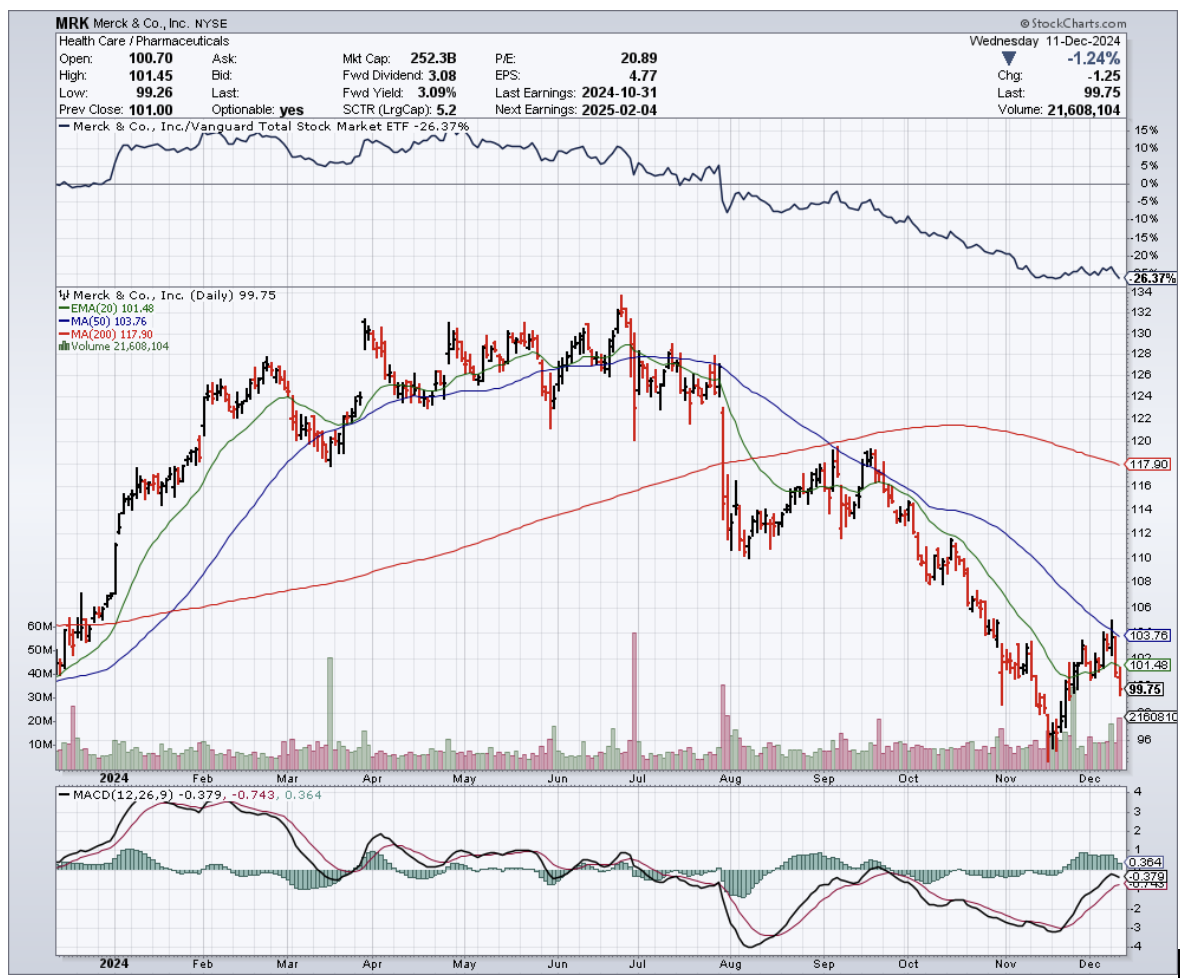
Mad Hedge Biotech and Healthcare Letter
October 10, 2024
Fiat Lux
Featured Trade:
(BUYING TIME)
(MRK), (JNJ)
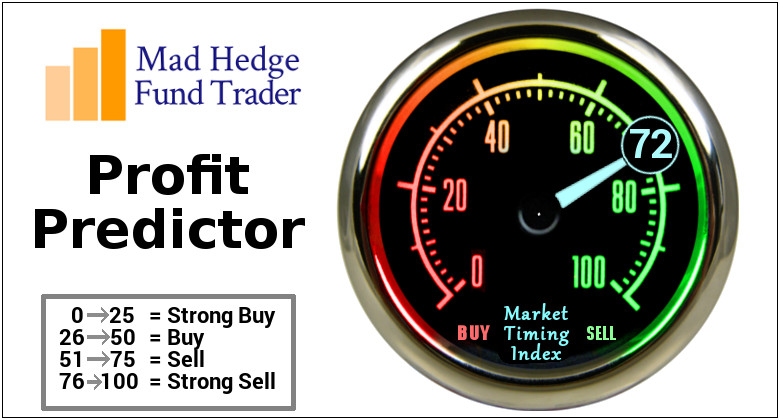
If you've been watching Merck (MRK) lately, you might think the pharmaceutical giant has caught a nasty case of the market flu. After years of being the biotech golden child, Merck's stock has been sliding down the charts faster than a greased pig at a county fair.
But before you start writing eulogies for this pharma powerhouse, let's dig into the nitty-gritty and see if there's still some fight left in this old dog.
First, let's talk about Keytruda. This cancer-fighting wonder drug is Merck's bread and butter, bringing in a whopping $7.3 billion in Q2 2024 alone. That's a 16% year-over-year jump, beating expectations by $100 million.
But here's the rub: Keytruda now accounts for nearly half of Merck's total revenue. It's like having a star quarterback who scores all your touchdowns - great until he sprains an ankle.
And boy, has Keytruda stubbed its toe lately. The FDA's advisory committee gave a thumbs down to expanding its use in certain stomach cancer patients.
Then there's the Phase 3 trial flop in colorectal cancer and two other discontinued trials. It's enough to make even the most bullish investor reach for the Tums.
With Keytruda showing signs of vulnerability, Merck's bigwigs have clearly decided it's time to spread their bets. They're not about to let their golden goose turn into a sitting duck. So, they’ve gone on a buying spree.
EyeBio, Elanco's Aqua business, Harpoon Therapeutics, CN201 - the list goes on. On paper, it looks smart. Diversify the portfolio, reduce the Keytruda dependency.
But Wall Street's not impressed, especially after Merck slashed its 2024 profit outlook by $1.05 per share to pay for this shopping spree.
Now, you might be wondering if Merck's lost its marbles with all this spending. Is Merck just throwing money around like a drunken sailor, or is this the kind of long-term thinking that separates the biotech wheat from the chaff? Only time will tell, but I've got a hunch these moves might pay off down the road.
Speaking of long-term thinking, Merck's not just acquiring companies left and right. They're also working on extending Keytruda's reign with a subcutaneous version that could push its patent protection into the late 2030s.
But they know better than to put all their eggs in one basket, even if it's a golden one.
That's where Merck's latest blockbuster deal comes in. They've just inked a $1.9 billion agreement with Mestag Therapeutics, a bold move into the world of inflammatory diseases. It's like Merck's discovered a new chess piece on the biotech board, and they're betting it could be a game-changer.
I know Mestag isn't exactly a household name, but these Cambridge, England-based whiz kids are doing some fascinating work with fibroblasts.
For those of you who forgot their biology lessons, fibroblasts are connective tissue cells that play a bigger role in inflammation and tumors than we once thought.
So why is Merck so excited about these little cellular workhorses?
Well, Merck's betting big that Mestag's Reversing Activated Fibroblast Technology (RAFT) platform could be the next big thing in inflammatory disease treatment. The deal gives Merck the option to license therapies against a "prespecified number of potential targets."
Mestag's got three preclinical programs in the pipeline. The frontrunner is MST-0300, a FAP-LTBR agonist designed to "supercharge" antitumor immunity.
Following close behind is M402, a stromal checkpoint agonist antibody aimed at dampening myeloid-driven biology in inflammatory disease.
Notably, Merck isn't the only big fish swimming in Mestag's pond. Johnson & Johnson's (JNJ) Janssen unit also signed its own two-target collaboration back in 2021.
With all these moves, you might be wondering if Merck's still a safe bet or if it's gone off the deep end.
Look, Merck's got more challenges than a one-armed juggler at the moment. But here's the thing: its current stock price is sitting at a level that's bounced back before.
With a solid 2.8% dividend yield that's been growing for 13 straight years, Merck might just be the kind of steady Eddie that value investors dream about.
Sure, there are risks. Keytruda's dominance is both a blessing and a curse. Also, those pricey acquisitions need to pay off. And who knows what Medicare will do next on drug pricing.
But if you've got the stomach for some short-term turbulence, Merck could be poised for a comeback. It's got a strong foundation, a pipeline full of potential, and enough cash to weather the storm. I suggest you buy the dip.
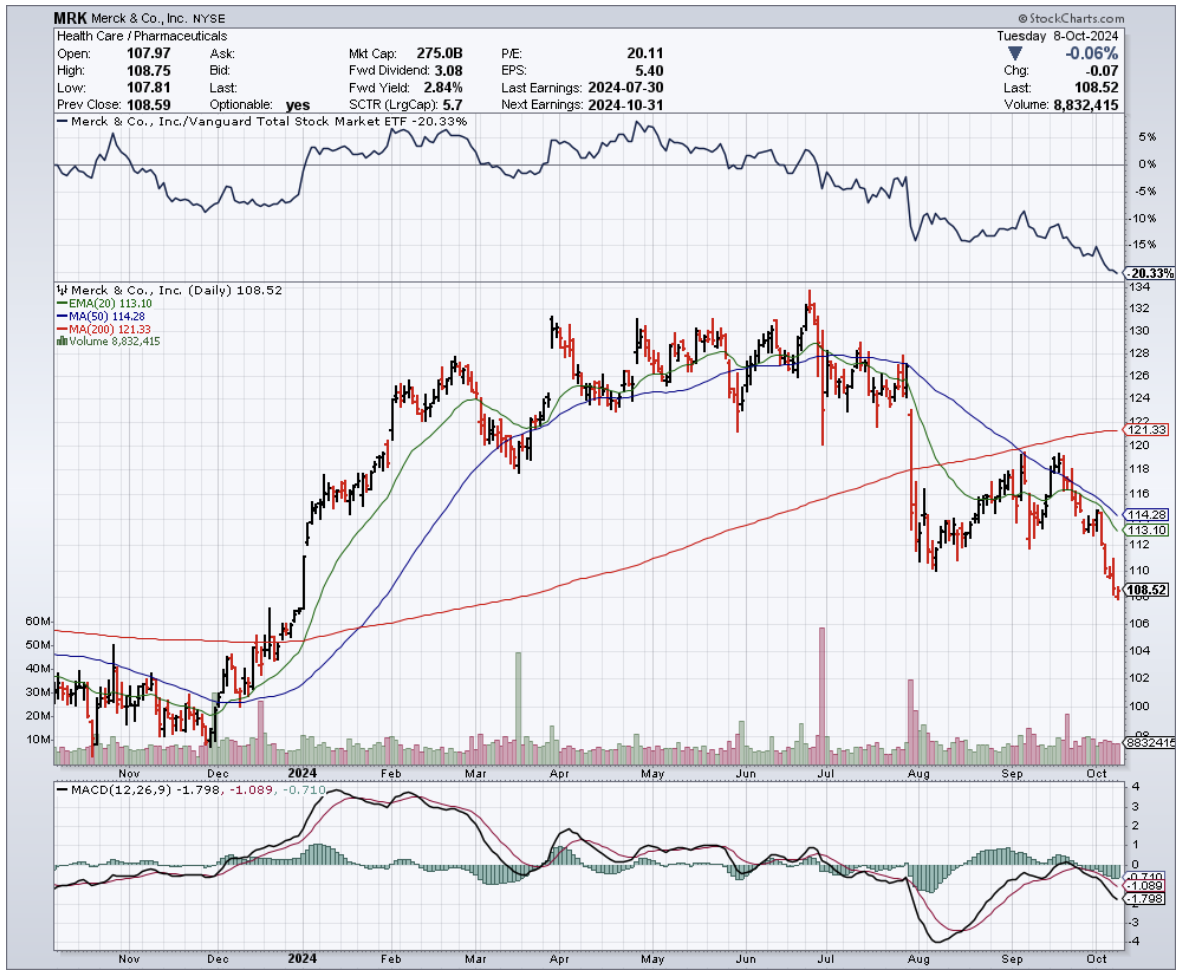
Mad Hedge Biotech and Healthcare Letter
September 12, 2024
Fiat Lux
Featured Trade:
(A SURPRISE UPPERCUT)
(MRK), (SMMT)
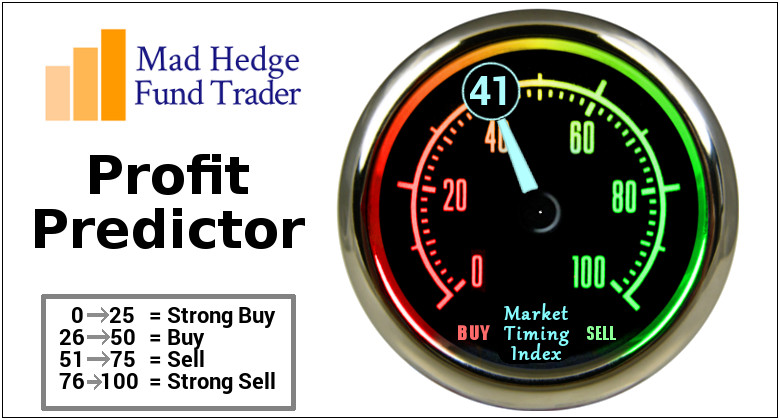
Mad Hedge Biotech and Healthcare Letter
September 10, 2024
Fiat Lux
Featured Trade:
(THE NEW SHOT CALLER)
(PCVX), (PFE), (MRK)
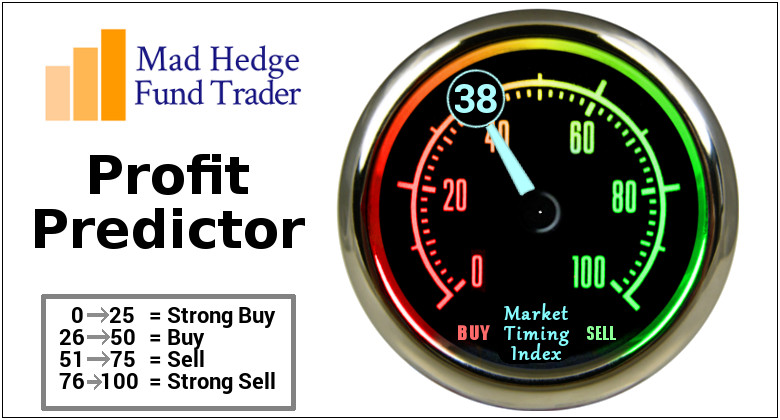
Mad Hedge Biotech and Healthcare Letter
August 29, 2024
Fiat Lux
Featured Trade:
(ONE TEST TO RULE THEM ALL)
(ILMN), (BAYRY), (LLY), (MRK), (BMY), (AZN), (RHHBY), (NVS), (GH), (TEM), (TMO)
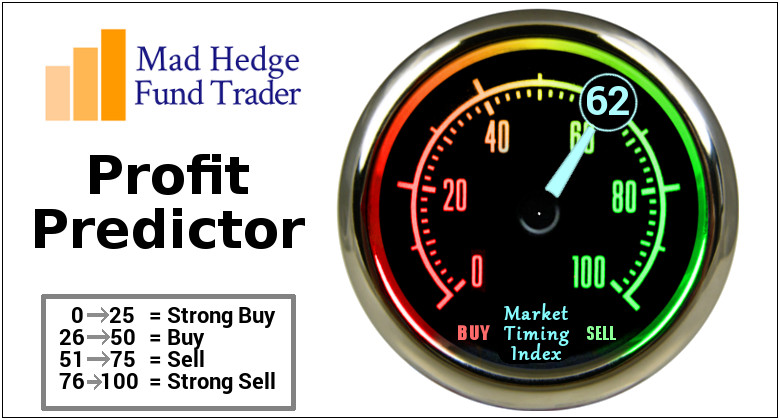
“One test to rule them all, one test to find them, one test to bring them all, and in the lab bind them,” the scientists at Illumina (ILMN) whispered – probably.
Their latest creation just got the FDA nod, and it's set to turn the world of cancer diagnostics on its head. It's as if Gandalf himself handed oncologists a palantír that reveals tumors' deepest secrets.
For those less versed in Middle-earth lore, this is like inventing a universal remote for tumor profiling, and oncologists can't wait to start channel surfing.
Now, you might be thinking, "What's the big deal?" Well, let me break it down for you.
This test, called TruSight Oncology Comprehensive (TSO for short), is the first FDA-approved genomic in vitro diagnostic kit that can make pan-cancer companion diagnostic claims.
In plain English, that means it's a single test that can be used across multiple cancer types. We're talking about a game-changer in precision oncology here.
Let's get into the nitty-gritty. This TSO test is a beast. It screens for a whopping 517 genes and provides comprehensive information on tumor mutational burden (TMB) and microsatellite instability (MSI).
These are crucial biomarkers that help determine how a patient might respond to immunotherapies. The breadth of data this single FDA-approved test can collect is unprecedented.
Now, you might be wondering, "Haven't we had companion diagnostics before?" Sure, but they've typically been limited to specific drugs or cancer types.
This pan-cancer test from Illumina is different. It can be applied to a wider range of solid tumors, and let me tell you, oncologists are loving it.
In fact, about 39% of U.S. oncologists have already said they strongly prefer using multi-gene panels over single-gene tests for guiding treatment decisions. That's a clear signal that there's demand for comprehensive diagnostic solutions like TSO.
Illumina's been busy across the pond, too. A version of this test has been available in Europe since 2022. But the U.S. version's got some new tricks up its sleeve.
It can help identify patients who might benefit from specific immunotherapies, including Bayer's (BAYRY) Vitrakvi and Eli Lilly's (LLY) Retevmo. The latter is a new addition compared to the EU version of the test.
Let's talk about these therapies for a second. Vitrakvi is used for adult and pediatric patients with certain NTRK mutations, regardless of their type of cancer. That's pretty cool, right?
But here's the kicker - these NTRK gene fusions are only found in about 0.1% to 0.3% of solid tumors, and they're tough to detect.
TSO's ability to scan both RNA and DNA means it can find multiple forms of this biomarker. That's a big deal for companies like Bayer, who've sometimes struggled to find eligible patients for this targeted therapy.
But Illumina's not resting on its laurels. They've got a growing pipeline of companion diagnostic claims in development, working hand in hand with drugmakers. They're planning to seek these in future regulatory submissions.
You see, Illumina's been playing the long game, forging partnerships with big pharma to co-develop companion diagnostics that align with targeted therapies.
Take their 2019 partnership with Merck (MRK), for instance. They teamed up to develop and commercialize a companion diagnostic using Illumina's TruSight Oncology 500 assay.
The goal? To identify genetic mutations in cancer patients that would respond to Merck's cancer drugs like Keytruda. This partnership boosted the adoption of Illumina's NGS platform in clinical oncology settings, contributing to both companies' growth.
The market liked what it saw at the time. Illumina's stock got a nice bump following the partnership announcement. And why wouldn't it?
The deal strengthened Illumina's position in the oncology diagnostics market, which is projected to grow at a CAGR of 12.4% from 2023 to 2030.
But Merck's not the only dance partner Illumina's got. They've also teamed up with Bristol-Myers Squibb (BMY) to use their TSO 500 assay as a companion diagnostic for immuno-oncology therapies.
This collaboration expanded Illumina's reach into new oncology applications, allowing BMY to use the TSO platform to identify patients most likely to benefit from its immune checkpoint inhibitors.
And there's more - Illumina's also forged partnerships with AstraZeneca (AZN), Roche (RHHBY), and Novartis (NVS) to develop companion diagnostic tests.
Next, let's talk numbers. Each new FDA-approved indication could potentially add $100 million to $200 million annually to Illumina's revenue. That's no chump change.
Unsurprisingly, Illumina's not the only player in this game.
Companies like Foundation Medicine (a Roche subsidiary), Guardant Health (GH), Tempus (TEM), Caris Life Sciences, Thermo Fisher Scientific (TMO), and GRAIL (another Illumina subsidiary) are all working towards pan-cancer or multi-cancer diagnostics.
Still, Illumina's TSO test is the first to secure FDA approval for pan-cancer companion diagnostic claims. This lead could translate into a significant market advantage.
Actually, Illumina already holds more than 70% market share in the global NGS market as of 2022. This means it’s well-positioned to benefit from this growth, and this latest FDA approval could further consolidate its market dominance.
Speaking of the FDA, they’ve been busy too. They've ramped up their support for precision medicine in recent years, approving a growing number of companion diagnostics and genomic tests.
From 2017 to 2021, they approved over 25 new companion diagnostics, a significant increase from the 5-10 approvals per year in the early 2010s. And a substantial portion of these approvals has been for oncology-related tests.
In 2021 alone, 68% of the FDA's new drug approvals were for cancer treatments.
Now, let's zoom out and look at the bigger picture. According to the World Health Organization, there were an estimated 19.3 million new cancer cases and 10 million cancer deaths worldwide in 2020.
The global cancer burden is expected to rise to 28.4 million cases by 2040, a 47% increase from 2020.
In the U.S., about 1.9 million new cancer cases are expected to be diagnosed in 2023.
The economic impact is also staggering. The economic burden of cancer in the U.S. was estimated at $157 billion in 2020, and it's projected to increase to over $246 billion by 2030.
These numbers stress the growing need for early detection and personalized treatment solutions.
But, unlike other companies, here's where advanced diagnostics like Illumina's TSO can make a difference. By ensuring patients receive the most effective treatments based on their genetic profiles, these tests can reduce unnecessary treatments and improve outcomes.
Studies have shown that using precision diagnostics can lower overall healthcare costs by 15% to 20% by avoiding ineffective therapies and hospitalizations.
Essentially, what we're seeing here is more than just a new test. It's a glimpse into the future of cancer treatment - more precise, more personalized, and potentially more effective.
For patients, it could mean better outcomes. For healthcare systems, it could mean more efficient use of resources. And for us? Well, it could mean significant opportunities in a rapidly growing market.
As Gandalf might say, "All we have to decide is what to do with the time that is given us." Illumina's chosen to use their time crafting this powerful new tool.
The quest to conquer cancer continues, and Illumina’s TSO might just be the ring-bearer we've been waiting for.
Keep your eyes peeled, fellow adventurers. The journey into precision oncology is only just beginning, and it promises to be an epic saga indeed.
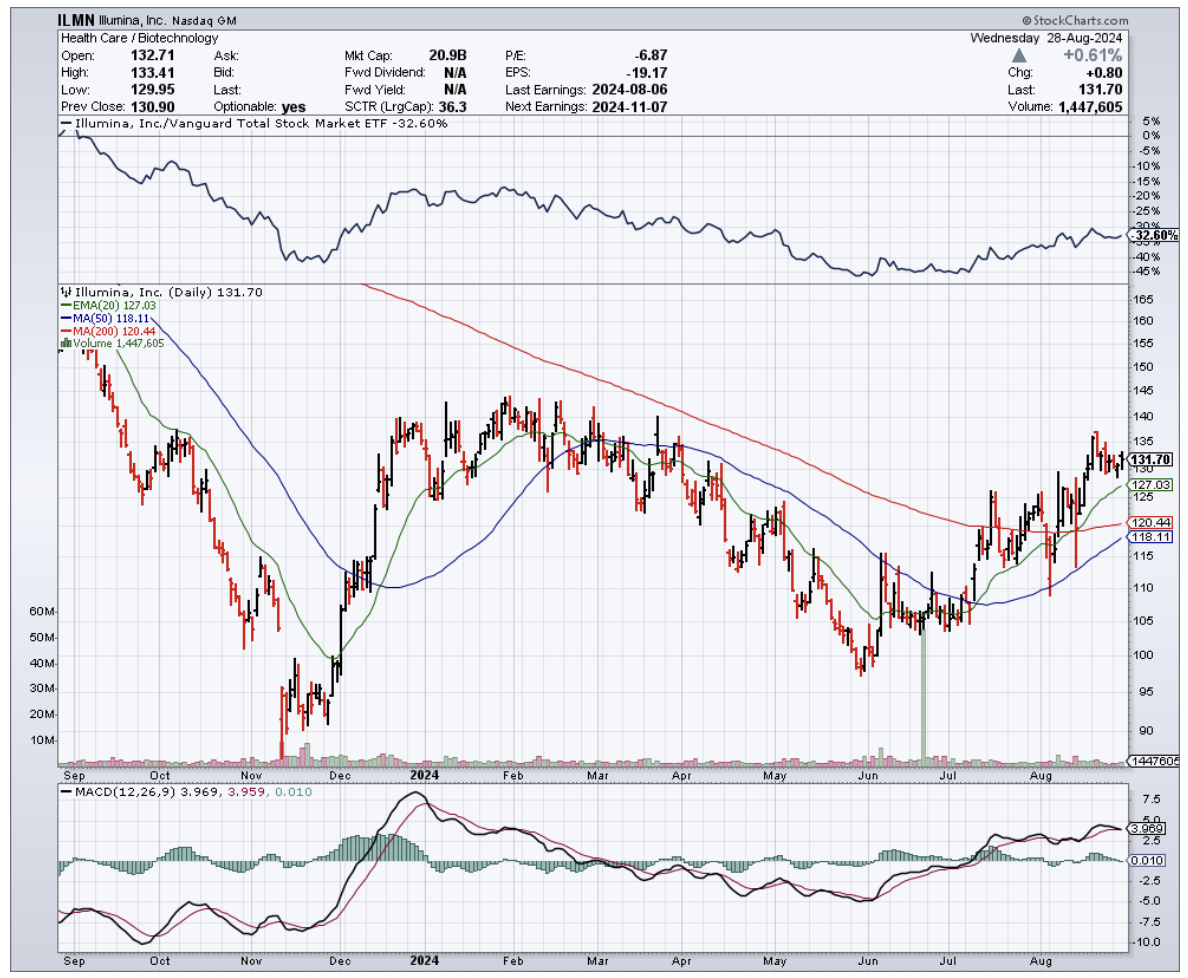
Legal Disclaimer
There is a very high degree of risk involved in trading. Past results are not indicative of future returns. MadHedgeFundTrader.com and all individuals affiliated with this site assume no responsibilities for your trading and investment results. The indicators, strategies, columns, articles and all other features are for educational purposes only and should not be construed as investment advice. Information for futures trading observations are obtained from sources believed to be reliable, but we do not warrant its completeness or accuracy, or warrant any results from the use of the information. Your use of the trading observations is entirely at your own risk and it is your sole responsibility to evaluate the accuracy, completeness and usefulness of the information. You must assess the risk of any trade with your broker and make your own independent decisions regarding any securities mentioned herein. Affiliates of MadHedgeFundTrader.com may have a position or effect transactions in the securities described herein (or options thereon) and/or otherwise employ trading strategies that may be consistent or inconsistent with the provided strategies.
This site uses cookies. By continuing to browse the site, you are agreeing to our use of cookies.
OKLearn moreWe may request cookies to be set on your device. We use cookies to let us know when you visit our websites, how you interact with us, to enrich your user experience, and to customize your relationship with our website.
Click on the different category headings to find out more. You can also change some of your preferences. Note that blocking some types of cookies may impact your experience on our websites and the services we are able to offer.
These cookies are strictly necessary to provide you with services available through our website and to use some of its features.
Because these cookies are strictly necessary to deliver the website, refuseing them will have impact how our site functions. You always can block or delete cookies by changing your browser settings and force blocking all cookies on this website. But this will always prompt you to accept/refuse cookies when revisiting our site.
We fully respect if you want to refuse cookies but to avoid asking you again and again kindly allow us to store a cookie for that. You are free to opt out any time or opt in for other cookies to get a better experience. If you refuse cookies we will remove all set cookies in our domain.
We provide you with a list of stored cookies on your computer in our domain so you can check what we stored. Due to security reasons we are not able to show or modify cookies from other domains. You can check these in your browser security settings.
These cookies collect information that is used either in aggregate form to help us understand how our website is being used or how effective our marketing campaigns are, or to help us customize our website and application for you in order to enhance your experience.
If you do not want that we track your visist to our site you can disable tracking in your browser here:
We also use different external services like Google Webfonts, Google Maps, and external Video providers. Since these providers may collect personal data like your IP address we allow you to block them here. Please be aware that this might heavily reduce the functionality and appearance of our site. Changes will take effect once you reload the page.
Google Webfont Settings:
Google Map Settings:
Vimeo and Youtube video embeds:
